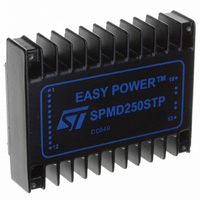SPMD250STP STMicroelectronics, SPMD250STP Datasheet - Page 22

SPMD250STP
Manufacturer Part Number
SPMD250STP
Description
MOD STEPPER MOTOR DRV 2.5A BIPO
Manufacturer
STMicroelectronics
Series
EASY POWER™r
Type
Stepper Motor Driverr
Datasheet
1.SPMD250STP.pdf
(28 pages)
Specifications of SPMD250STP
Motor Type
Stepper, Bipolar
Number Of Motors
1
Voltage - Output
40V
Voltage - Logic Supply
4.5 V ~ 5.5 V
Current - Output
2.5A
Transistor Type
MOSFET
Termination Style
PC Pin
Operating Temperature Classification
Industrial
Operating Supply Voltage (min)
12V
Operating Supply Voltage (typ)
5V
Operating Supply Voltage (max)
40V
Product
Stepper Motor Controllers / Drivers
Operating Supply Voltage
5 V
Mounting Style
SMD/SMT
For Use With
497-10050 - BOARD EVAL SPMD250497-9011 - DEMO SYSTEM BASED ON SPMD250STP
Lead Free Status / RoHS Status
Lead free / RoHS Compliant
Other names
497-8416
Available stocks
Company
Part Number
Manufacturer
Quantity
Price
Company:
Part Number:
SPMD250STP
Manufacturer:
AD
Quantity:
101
Company:
Part Number:
SPMD250STP
Manufacturer:
STMicroelectronics
Quantity:
136
Thermal operating conditions
11
22/28
Thermal operating conditions
In many cases the modules do not require any additional cooling because the dimensions
and the shape of the metal box are studied to offer the minimum possible thermal resistance
case-to-ambient for a given volume.
It should be remembered that these modules are a power device and, depending on
ambient temperature, an additional heath-sink or forced ventilation or both may be required
to keep the unit within safe temperature range. (Tcasemax < 85 °C during operation).
The concept of maximum operating ambient temperature is totally meaningless when
dealing with power components because the maximum operating ambient temperature
depends on how a power device is used.
What can be unambiguously defined is the case temperature of the module.
To calculate the maximum case temperature of the module in a particular applicative
environment the designer must know the following data:
●
●
●
●
From these data it is easy to determine whether an additional heath-sink is required or not,
and the relevant size i.e. the thermal resistance.
The step by step calculation is shown for the following example.
Vin = 40 V, Iphase = 1 A, Rph phase resistance = 10 Ω, max. T
●
●
●
●
FAST DECAY. For this mode of operation, the internal voltage drop is Vsatsource + Vsatsink
during the ON period i.e. for 25% of the time.
During the recirculation period (75% of the time), the current recirculates on two internal
diodes that have a voltage drop Vd = 1 V, and the internal sense resistor (0.5 Ω). For this
example, by assuming maximum values for conservative calculations, the power dissipation
during one cycle is:
Input voltage
Motor phase current
Motor phase resistance
Maximum ambient temperature
Calculate the power dissipated from the indexer logic and the level shifter (see
electrical characteristics):
Plogic = (5 V x 60 mA) + (40 V x 20 mA) = 1.1 W
Calculate the average voltage across the winding resistance:
Vout = (Rph x Iout) = 10 Ω
Calculate the required ON duty cycle (D.C.) of the output stage to obtain the average
voltage (this D.C. is automatically adjusted by the SPMD250STP):
Calculate the power dissipation of the SPMD250STP output power stage. The power
dissipation depends on two main factors:
–
–
Ppw = 1.1 x [2 Vsat x Iph x D.C. + 2 Vd x Iph x (1 - D.C.) + 0.5 x Iph]
DC
=
The selected operating mode (FAST or SLOW DECAY)
The selected drive sequence (WAVE, NORMAL, HALF STEP)
V
--------------
V
OUT
IN
=
10
----- -
40
=
0.25
Doc ID 14350 Rev 2
→
1 A = 10 V
A
= 50 °C
SPMD250STP











